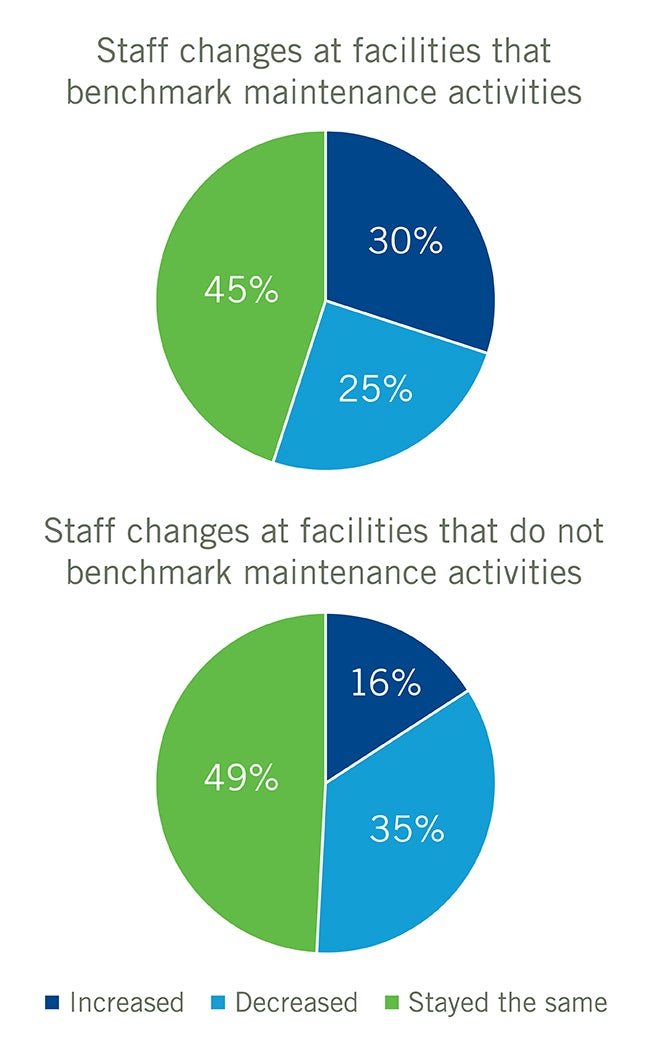Benchmarking may lead to more resources
Benchmarking is not just a tool for measuring performance. The insights gained from setting standards and tracking performance can provide guidance on how to invest in an operation. And because numbers help to paint a story, those insights also can help when advocating for more resources for staff and projects.
In the 2024 Hospital Operations Survey, conducted by the American Society for Health Care Engineering’s Health Facilities Management magazine, respondents were asked if they benchmarked and tracked any of their maintenance activities. The majority of respondents (72%) said they did, compared to 28% who said they did not. (For the remainder of this column, these two subsets will be referred to as “benchmarkers” and “non-benchmarkers.”)
Not surprisingly, benchmarkers tended to implement other maintenance best practices at a higher degree than non-benchmarkers. For instance, while an impressive 85% of non-benchmarkers said they document maintenance procedures, an even higher percentage of benchmarkers also have that same practice at 97%. When it comes to setting measurements for staff needs, 54% of the benchmarkers said they have a formal practice in place, compared to only 33% of non-benchmarkers.
The same trend appears when looking at newer, more sophisticated practices. For instance, 26% of benchmarkers say they have practiced some measure of reliability-centered maintenance at their organizations. That number may appear low until you compare it with only 8% of non-benchmarkers who can say the same.
From this data, one can surmise that leaders who benchmark maintenance activities also are leaders who will engage in other maintenance best practices in higher numbers than their counterparts.
But in digging deeper into the differences between these two groups, whether they followed certain best practices or implemented new strategies were not the only correlations that stood out. There also were differences in results, such as being able to grow staff, obtain funding for deferred maintenance and increase their budgets.
Although staff shortages are an issue for nearly every health care facility, benchmarkers report greater success in growing their staff numbers over the past three years, with 30% saying they’ve had their staff increase, compared to only 16% of non-benchmarkers. Also, a smaller percentage of benchmarkers reported staff decreases than non-benchmarkers.
The two sample groups also fared differently in funding increases and decreases. Benchmarkers secured funding for more of their deferred maintenance backlog, with 16% reporting they were able to secure funding for 30% to 100% of their deferred maintenance projects, compared to just 10% of non-benchmarkers who received the same level for their backlog.
A similar trend appears when looking at overall budget increases. While 40% of non-benchmarkers were able to increase their budgets by greater than 1% from 2023 to 2024, a larger percentage of benchmarkers report the same, with 48% increasing their budgets by greater than 1%.
So, what’s the story here? Are leaders who benchmark innately better at achieving funding for their much-needed projects, or is there more to it?
In one of his Sherlock Holmes novels, author Sir Arthur Conan Doyle pens the lead character as saying, “It is a capital mistake to theorize before one has data.” Perhaps the biggest factor in successfully advocating for more resources between these two groups is just that — data.
This is not to say that many facilities managers do not know the acute needs and ins and outs of their facilities without data, but having hard numbers to prove a “gut feeling” can be hugely useful when advocating for departmental needs in organizations where resources are limited.
Data as a tool for advocacy enhances intuition and helps create a bridge for those who do not have the same day-in and day-out knowledge of a facility’s maintenance needs.
As an encouragement to those who have not started this journey, remember that a system need not be perfect to be purposeful. Starting somewhere is better than starting nowhere.
About this column
“Data Insights” dissects information collected through the American Society for Health Care Engineering’s Hospital Operations, Hospital Construction and Salary surveys. The column pulls from original research to discuss nuanced issues affecting health facilities professionals across the United States.
Jamie Morgan, senior editor of Health Facilities Management.





